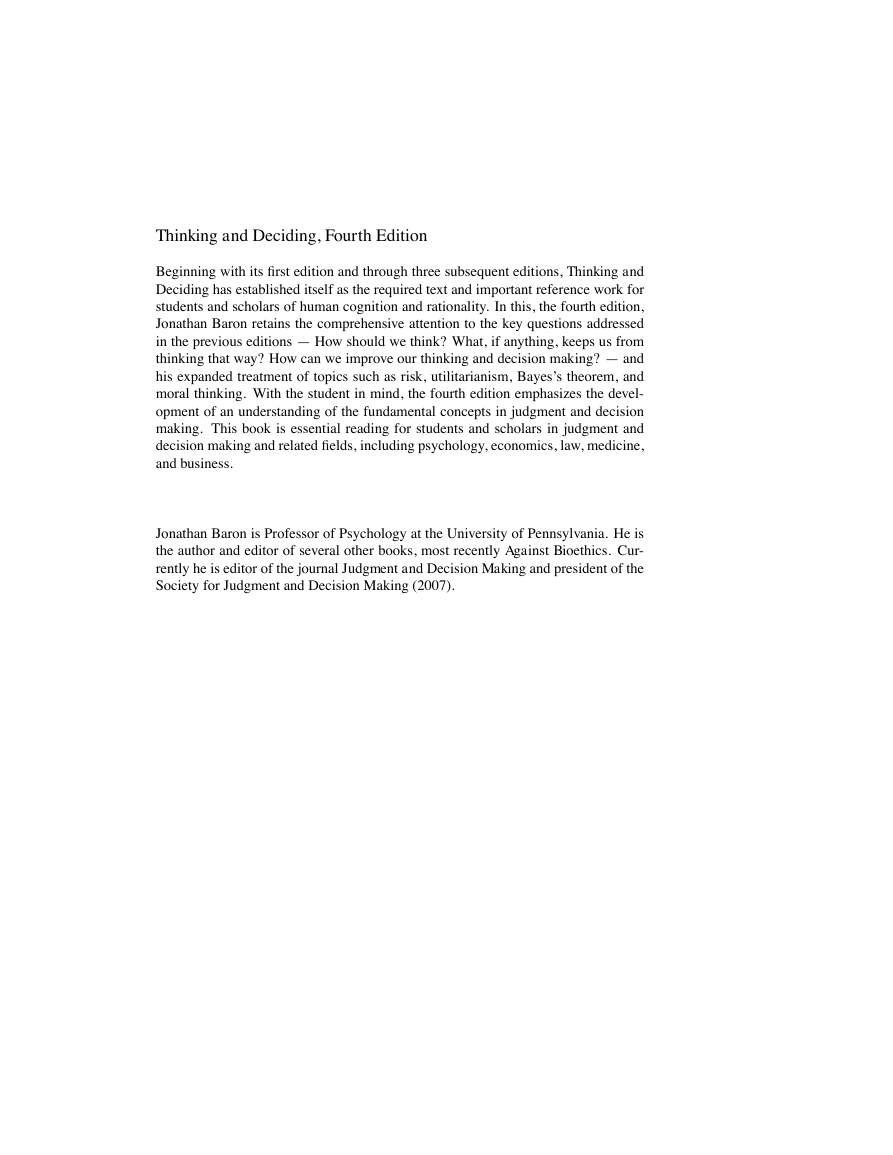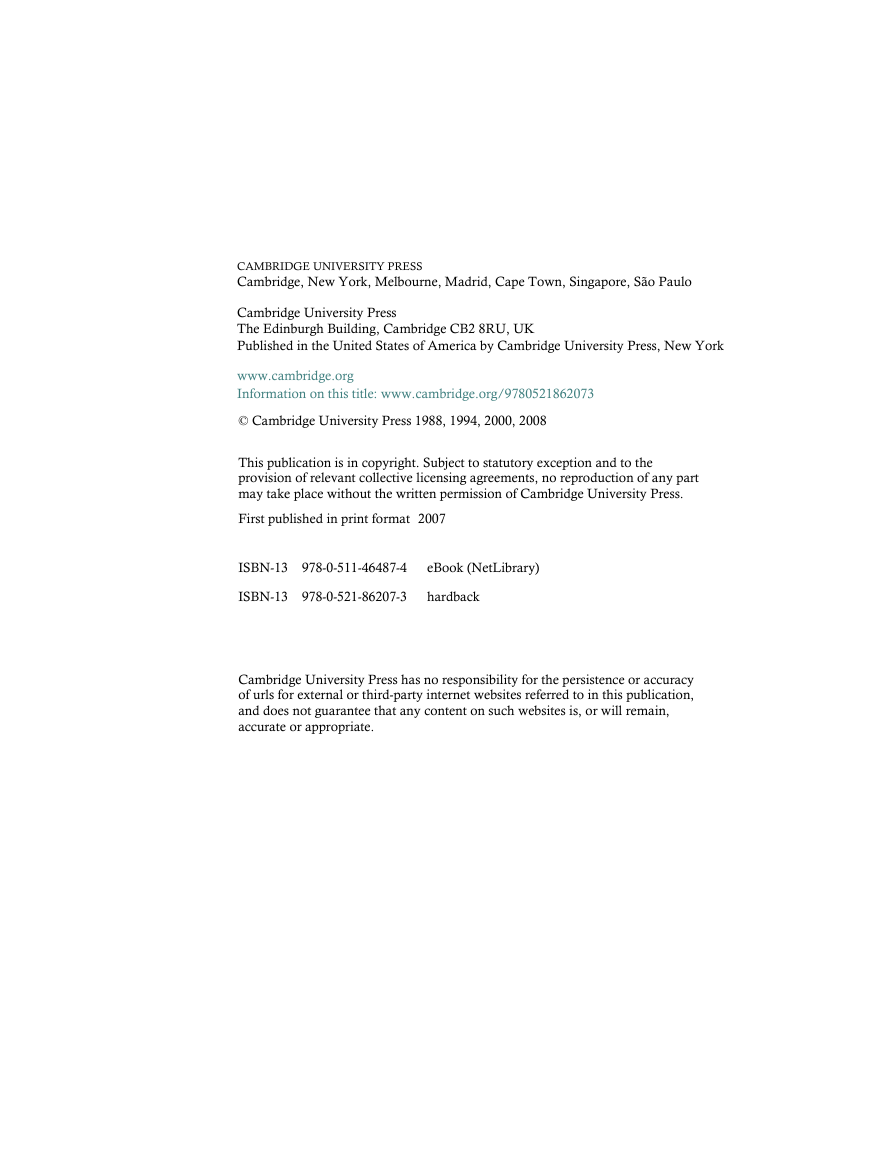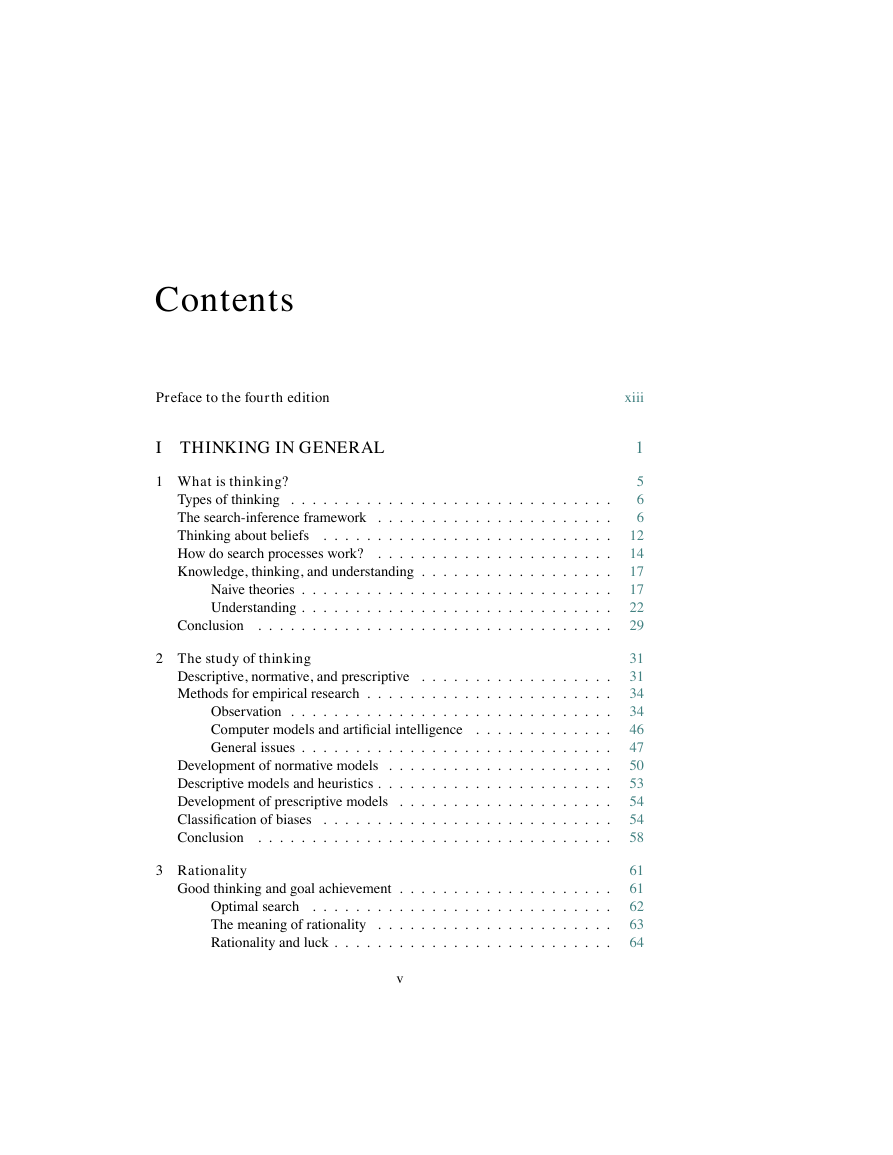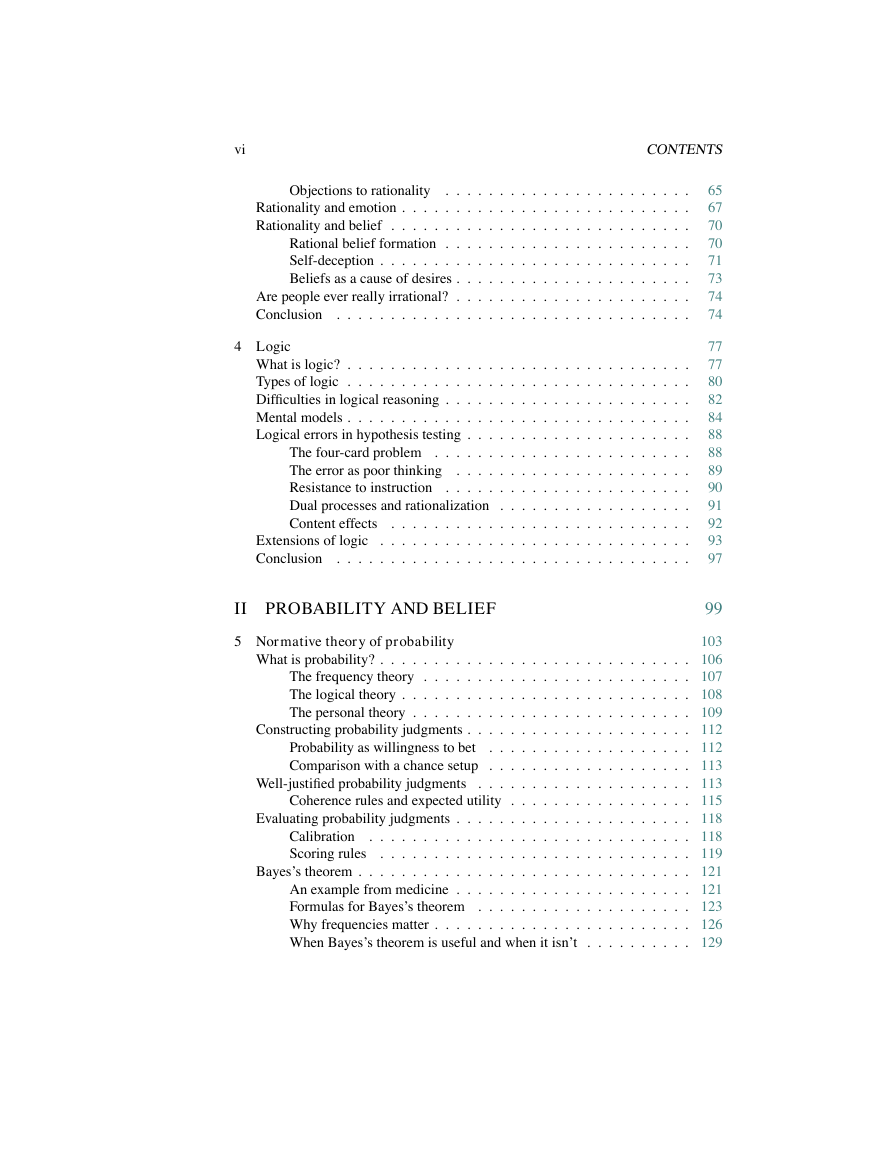Half-title
Title
Copyright
Contents
Preface to the fourth edition
Part I THINKING IN GENERAL
Chapter 1 What is thinking?
Types of thinking
The search-inference framework
Thinking about beliefs
How do search processes work?
Knowledge, thinking, and understanding
Naive theories
Understanding
Wertheimer and Katona
What is understanding?
Conclusion
Chapter 2 The study of thinking
Descriptive, normative, and prescriptive
Methods for empirical research
Observation
Process tracing
Interviews
Use of archival data
Hypothetical scenarios
Individual differences
Training and debiasing
Experimental economics
Physiological measurements
Computer models and artificial intelligence
General issues
Within-subject versus between
Sampling
Incentives
Development of normative models
Descriptive models and heuristics
Development of prescriptive models
Classification of biases
Conclusion
Exercise: Making a think-aloud protocol
Chapter 3 Rationality
Good thinking and goal achievement
Optimal search
The meaning of rationality
Rationality and luck
Objections to rationality
Rationality and emotion
Rationality and belief
Rational belief formation
Self-deception
Beliefs as a cause of desires
Are people ever really irrational?
Conclusion
Chapter 4 Logic
What is logic?
Types of logic
Difficulties in logical reasoning
Mental models
Logical errors in hypothesis testing
The four-card problem
The error as poor thinking
Resistance to instruction
Dual processes and rationalization
Content effects
Extensions of logic
Conclusion
Part II PROBABILITY AND BELIEF
Chapter 5 Normative theory of probability
What is probability?
The frequency theory
The logical theory
The personal theory
Constructing probability judgments
Probability as willingness to bet
Comparison with a chance setup
Well-justified probability judgments
Coherence rules and expected utility
Evaluating probability judgments
Calibration
Scoring rules
Bayes's theorem
An example from medicine
Formulas for Bayes's theorem
Why frequencies matter
When Bayes's theorem is useful and when it isn't
Coincidences
The Monty Hall problem
Use of Bayes's theorem in expert systems
Conclusion
Chapter 6 Descriptive theory of probability judgment
Accuracy of probability judgments
Frequency judgments
Calibration and inappropriate extreme confidence
Improving calibration by conditional assessment
Heuristics and biases in probability
The representativeness heuristic
Tom W.
Stereotypes and the nature of the bias
The taxicab problem
The conjunction fallacy
The gambler's fallacy and probability matching
The availability heuristic
Subadditivity
Hindsight bias
Averaging
Conclusion
Chapter 7 Hypothesis testing
Hypotheses in science
An example from medicine
Testing scientific hypotheses
The psychology of hypothesis testing
Concept formation
Congruence bias
Information bias and the value of information
Utility and alternative hypotheses
Conclusion
Chapter 8 Judgment of correlation and contingency
Correlation, cause, and contingency
Accuracy of judgment
Attentional bias
Attentional bias in judging correlation
Attentional bias in judging contingency
Effect of goals on illusion of control
Effects of prior belief
Illusory correlation
Personality traits
Prior belief and attentional bias
Understanding theory and evidence
Conclusion
Chapter 9 Actively open-minded thinking
Examples of actively open-minded thinking
Myside bias and irrational belief persistence
The order principle, the primacy effect, and total discrediting
The neutral-evidence principle
Effect of active open-mindedness on outcomes
Determinants and related phenomena
Beliefs about thinking
Distortion of beliefs by desires
Related results
Selective exposure
Belief overkill
Factors that moderate belief persistence
Elastic justification
Value conflict
Accountability
Stress
Groupthink
Conclusion
Part III DECISIONS AND PLANS
Chapter 10 Normative theory of choice under uncertainty
Expected-utility theory
Expected value
Expected utility
Other examples of comparison of errors
Why expected-utility theory is normative
The long-run argument
The argument from principles
An alternative principle: Tradeoff consistency
The utility of money
Conclusion
Chapter 11 Descriptive theory of choice under uncertainty
Experienced, predicted, and decision utility
Bias in decisions under uncertainty
The Allais paradox
Prospect theory
Probability: The pi function
Utility: The Value function and framing effects
Extending prospect theory to events without stated probabilities
Rank-dependent utility theories
Emotional effects of outcomes
Regret and rejoicing
Disappointment and elation
The role of regret in decisions
Rationality of regret and disappointment in decision making
The ambiguity effect
Ambiguity and "unknown probability"
Rationality of the ambiguity effect
Aversion to missing information
Ambiguity and adjustment of probability
Uncertainty and reasons for choice
Conclusion
Chapter 12 Choice under certainty
Prominence and noncompensatory strategies
Other reversals: Compatibility and evaluability
Response mode compatibility
Evaluability and joint versus separate evaluation
Effects of the options available on choice
Asymmetric dominance
Compromise
Mental accounting
The status quo (endowment) effect
Omission bias and default bias
Emotional effects of the reference point
Opportunity costs
Positive and negative attributes
Integration and segregation
The extra-cost effect
The sunk-cost effect
The reference price
Conclusion
Chapter 13 Utility measurement
Decision analysis and related methods
The Oregon Health Plan
Decision analysis versus cost-benefit analysis
The measurement of utility
Utility measurement as prediction
Direct versus indirect judgments
Simple direct judgment and the analog scale
Difference measurement
Standard gambles
Time tradeoff and person tradeoff
What counts in health utility?
Adaptation and point of view
Other methods involving matching and comparison
Contingent valuation (CV)
Insensitivity to quantity
Sensitivity to cost
WTA (willingness to accept) is larger than WTP
Disagreement among measures
Conclusion
Chapter 14 Decision analysis and values
Fundamental versus means values
Discovering values
Objectives of hiring a new faculty member in psychology
Conjoint measurement
MAUT as a type of decision analysis
Rules and tradeoffs
The value of human life
Teaching decision analysis
Conclusion
Chapter 15 Quantitative judgment
Multiple linear regression
The lens model
The mechanism of judgment
Do people really follow linear models?
Impression formation
Averaging, adding, and number of cues
Representativeness in numerical prediction
Anchoring and underadjustment
Simple heuristics for judgment
Elimination by aspects
Other simple heuristics
Classification
Functional measurement and conjoint analysis
Conclusion
Chapter 16 Moral judgment and choice
What are moral judgments?
Imperatives and the naturalistic fallacy
Relativism
Types of judgment
Morality versus convention
Social norms
Moral realism
Utilitarianism as a normative model
Moralistic goals
Frequently asked questions about utilitarianism
What if people want something that is wrong?
Does utilitarianism require perfect altruism?
Is it about happiness?
Does utilitarianism require calculation?
Interpersonal comparison
Utilitarianism and expected utility
Deontological rules
Rule utilitarianism
Biases in moral judgment?
Acts and omissions
Other possible biases
Protected values
Retribution
Hurting some to help others
Exploitation and inequity
Indirectness and the double effect
Agent relativity
Naturalism
Physical proximity
Can intuitions be values?
Conclusion
Chapter 17 Fairness and justice
The study of fairness and justice
Equity theory: The desire for justice
Utilitarianism and fairness
Intuitions
Heuristics and self-interest
Negotiation
Conclusion
Chapter 18 Social dilemmas: Cooperation versus defection
Laboratory versions
Prisoner's dilemma
Effects of repetition
N-person prisoner's dilemma
Normative and prescriptive theory of social dilemmas
Motives in social dilemmas
Altruism
Competition
Fairness, equality, and envy
Fear and greed
Reasons for doing what others do
Trust
Voters' illusions
Solutions to social dilemmas
Experimental approaches
Penalties
Second-order social dilemmas
The power of voting
Unfairness
Culture
Group discussion
Social reform
Conclusion
Chapter 19 Decisions about the future
The choice of personal goals
Good reasons for sticking to plans
Bad reasons for sticking to plans: Biases
Discounting
Economic theory of discounting
Normative theory of discounting
Descriptive data on discounting
The subjective discount rate
Dynamic inconsistency
Other factors
The rationality of personal discounting
Self-control
Why we need self-control
Methods of self-control
Emotions and time
Adaptation, contrast, and heuristics
Morality and prudence
Conclusion
Chapter 20 Risk
Normative theory
Public control of risk
Torts
Compensation
Private insurance
Investment and entrepreneurs
Risk regulation and the intuitions that support it
The psychometric approach
Voluntary versus involuntary
Known versus unknown
Catastrophic versus individual
Benefit
Other biases in risk judgments
Neglect of probability
Proportions versus differences
Zero risk
Individual versus statistical
Natural versus artificial
Omission versus commission
Intuitive toxicology and naive theories
Intuitions about tort law
Insurance and protective behavior
Investors and entrepreneurs
Individual and sex differences
Conclusion
References
Author Index
Subject Index
















 2023年江西萍乡中考道德与法治真题及答案.doc
2023年江西萍乡中考道德与法治真题及答案.doc 2012年重庆南川中考生物真题及答案.doc
2012年重庆南川中考生物真题及答案.doc 2013年江西师范大学地理学综合及文艺理论基础考研真题.doc
2013年江西师范大学地理学综合及文艺理论基础考研真题.doc 2020年四川甘孜小升初语文真题及答案I卷.doc
2020年四川甘孜小升初语文真题及答案I卷.doc 2020年注册岩土工程师专业基础考试真题及答案.doc
2020年注册岩土工程师专业基础考试真题及答案.doc 2023-2024学年福建省厦门市九年级上学期数学月考试题及答案.doc
2023-2024学年福建省厦门市九年级上学期数学月考试题及答案.doc 2021-2022学年辽宁省沈阳市大东区九年级上学期语文期末试题及答案.doc
2021-2022学年辽宁省沈阳市大东区九年级上学期语文期末试题及答案.doc 2022-2023学年北京东城区初三第一学期物理期末试卷及答案.doc
2022-2023学年北京东城区初三第一学期物理期末试卷及答案.doc 2018上半年江西教师资格初中地理学科知识与教学能力真题及答案.doc
2018上半年江西教师资格初中地理学科知识与教学能力真题及答案.doc 2012年河北国家公务员申论考试真题及答案-省级.doc
2012年河北国家公务员申论考试真题及答案-省级.doc 2020-2021学年江苏省扬州市江都区邵樊片九年级上学期数学第一次质量检测试题及答案.doc
2020-2021学年江苏省扬州市江都区邵樊片九年级上学期数学第一次质量检测试题及答案.doc 2022下半年黑龙江教师资格证中学综合素质真题及答案.doc
2022下半年黑龙江教师资格证中学综合素质真题及答案.doc